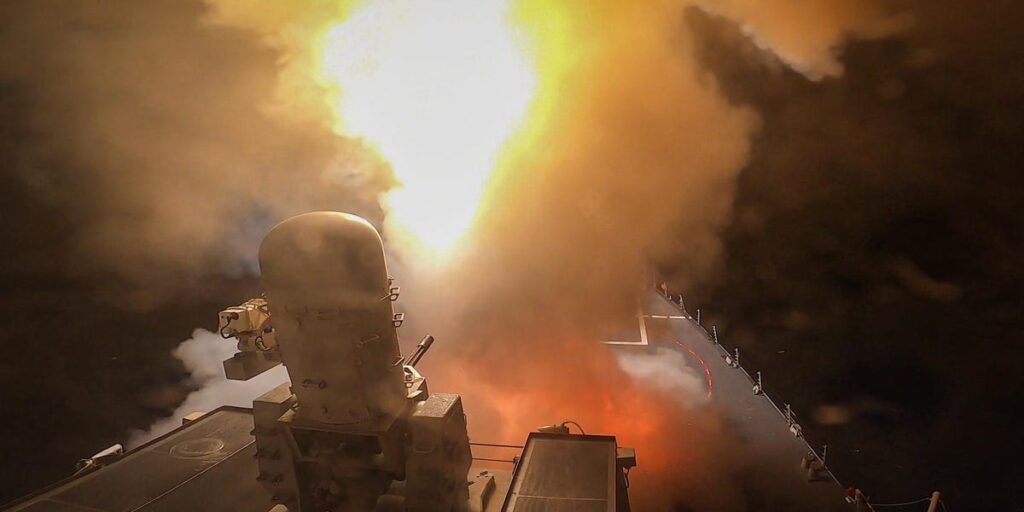Picking the right weapon to match the threat as the US Navy battled the Houthis in the Red Sea came with a “learning curve” for the service, President Donald Trump’s choice for top admiral said Thursday.
Top military officials and observers have long expressed concern over the Navy’s munitions expenditure and raised questions about the sustainability of firing high-end munitions in high-tempo environments.
On Thursday, Adm. Daryl Caudle, Trump’s pick to be the next chief of naval operations, told the Senate Committee on Armed Services during his confirmation hearing that the Red Sea fights led to lessons on what weapons and interceptors were best for shooting down specific enemy threats and helped to improve the Aegis Combat System’s decision-making.
Aegis is the Navy’s integrated air defense system, featuring radar, a vertical launch system for various missiles, and a combat management system that uses sensors to identify threats. Built to assist with tracking and engagement, it is currently fitted on Arleigh Burke-class destroyers and Ticonderoga-class cruisers.
Caudle explained to the committee members that the engagement data from the Red Sea battles led to “the evolution of actually attacking each attack with the right munitions,” including “using more air-to-air assets, which are cheaper than an SM-6 or an SM-2, and using electronic warfare to do that when possible.”
“So the learning curve has been great there,” he said.
The US Navy has been involved in numerous air defense engagements around the Middle East since October 2023. In the Red Sea and Gulf Aden, US warships have shot down hundreds of missiles and drones fired by the Iranian-backed Houthi rebels in Yemen toward commercial shipping lanes.
Top Navy officials have said American forces have fired significant numbers of munitions costing billions of dollars in these engagements, at times expending multimillion-dollar missiles to destroy cheap Houthi drones that can cost just thousands of dollars each.
While the Navy still maintains a robust arsenal, there are concerns about the overreliance on high-end interceptors, such as the SM-6 and SM-2, in high-tempo operations.
The SM-2 is a workforce naval air defense missile that costs about $2 million, the SM-6 costs about $4 million and serves as a multi-mission interceptor, and then there’s the SM-3 for ballistic missile defense. With the SM-3’s ability to engage threats in space, this sophisticated weapon can range in price between $10 million and almost $30 million, depending on the variant. These costly interceptors have seen use in the Navy’s defense of Israel against the threat of Iranian ballistic missiles.
Some experts and officials have argued that the SM family of interceptor missiles would be critical should the US go to war with China and that it’s necessary to stockpile missiles.
On the SM-3 and SM-6 missiles, in particular, the acting chief of naval operations, Adm. James Kilby, recently told Business Insider that heavy reliance on these is “unsustainable” in high-tempo fights.
There are only so many options for ballistic missiles, but there are alternatives to expensive interceptors for defeating drones and other lower-end threats.
During the recent Operation Rough Rider, US forces turned to laser-guided rockets like the AGR-20 Advanced Precision Kill Weapon System, which costs roughly $25,000. Navy officials have noted that bringing the cost of what’s being fired and the threat it’s engaging closer to parity is a priority. Almost half of all drone kills during that operation involved the APKWS.
Other options include electronic warfare and, though it’s not exactly inexpensive, air-to-air missiles.
In pre-answered questions before the Senate hearing, Caudle said that the demand for the Navy’s munitions had increased significantly in recent years and that maintaining a strong munitions industrial base was vital for sustainment in a potential conflict.
He added that this required stronger relationships with defense industry partners to improve capacity and the supply chain, a major issue that has been noted by other Navy officials as they examine the costs, timelines, and acquisitions of expensive munitions.
Read the full article here


